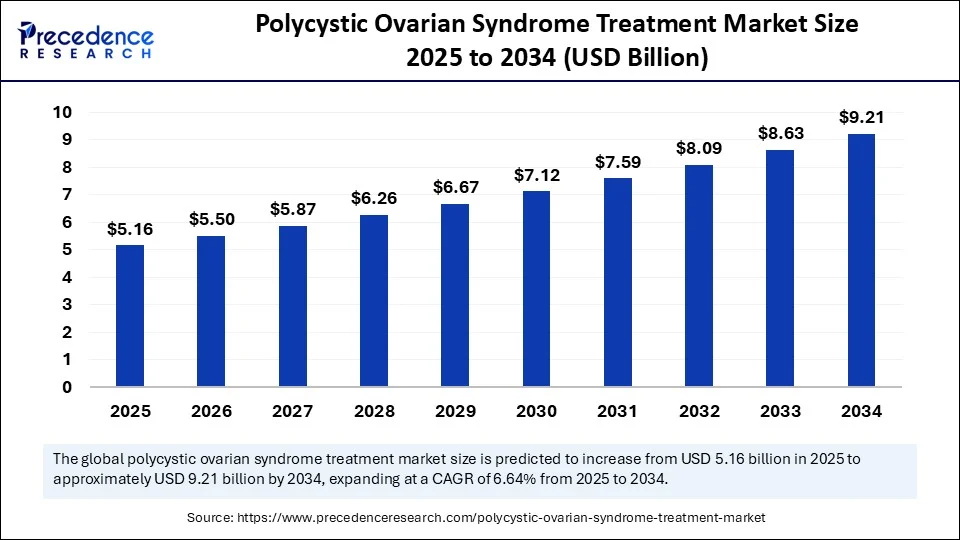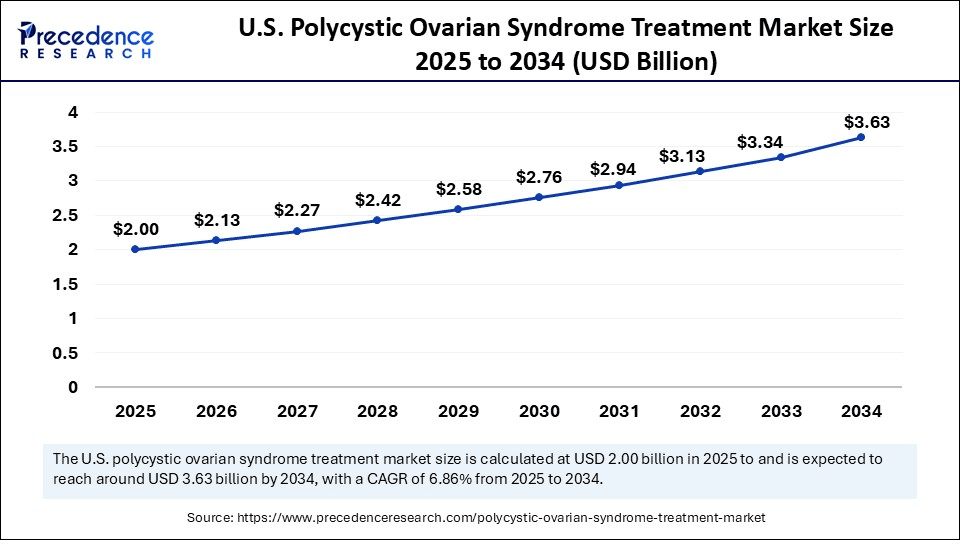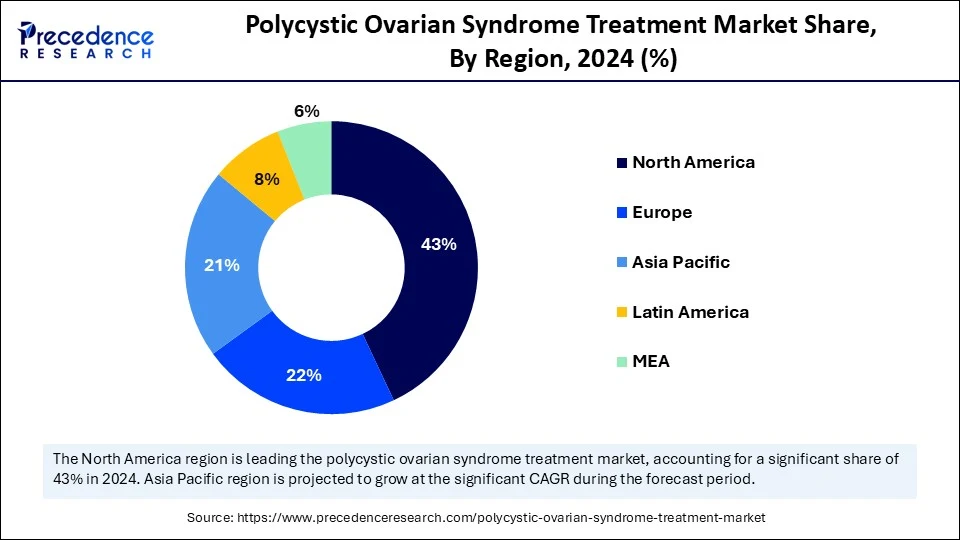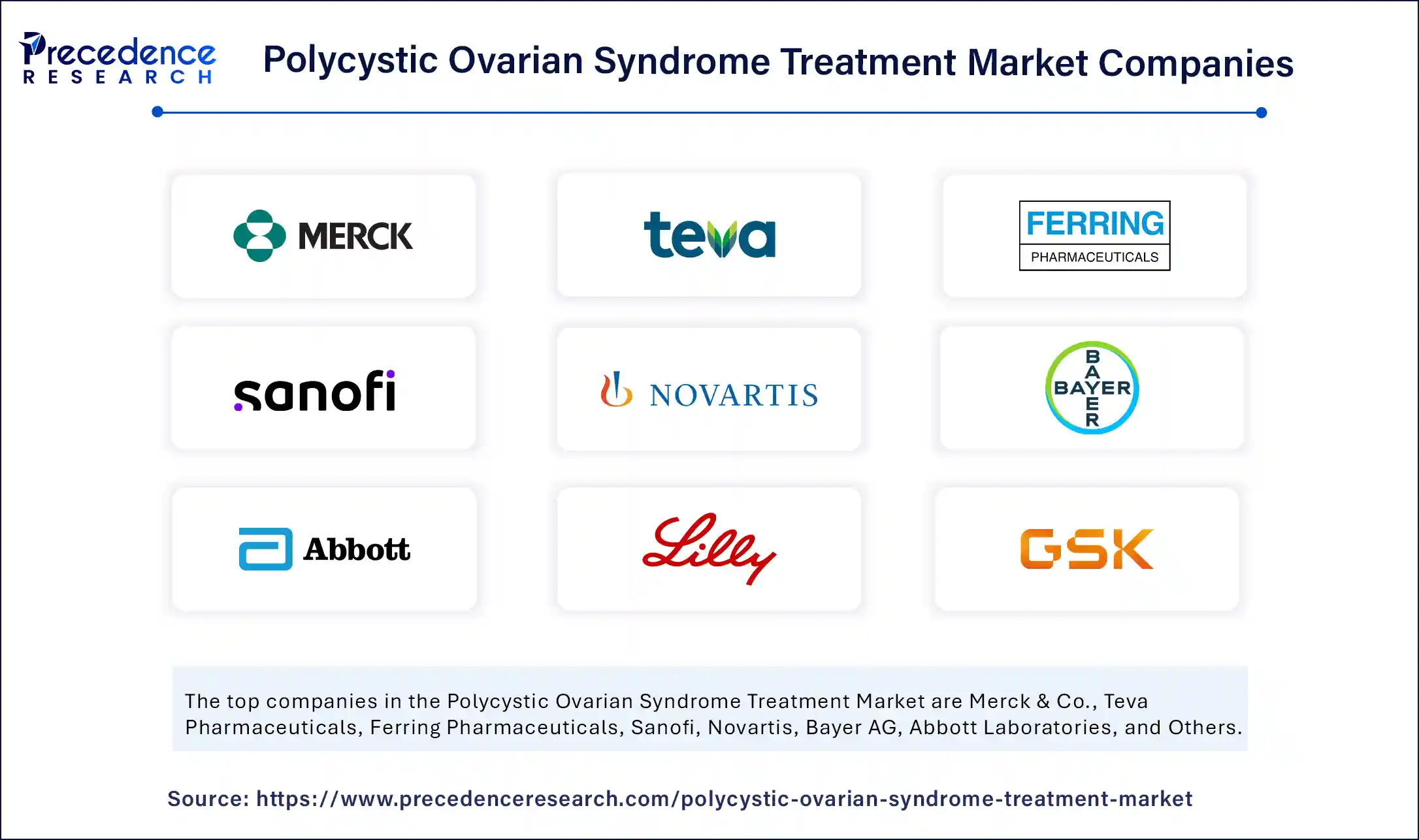List of Contents
Polycystic Ovarian Syndrome Treatment Market Size and Forecast 2025 to 2034
The global polycystic ovarian syndrome treatment market size was estimated at USD 4.84 billion in 2024 and is predicted to increase from USD 5.16 billion in 2025 to approximately USD 9.21 billion by 2034, expanding at a CAGR of 6.64% from 2025 to 2034. The market is witnessing substantial growth because of the rising prevalence of hormonal and lifestyle-related disorders, increased awareness of early diagnosis, and the adoption of combination therapies. Advances in hormonal drugs and personalized treatments are expected to sustain this growth in the upcoming years.

Polycystic Ovarian Syndrome Treatment Market Key Takeaways
- In terms of revenue, the global polycystic ovarian syndrome treatment market was valued at USD 4.84 billion in 2024.
- It is projected to reach USD 9.21 billion by 2034.
- The market is expected to grow at a CAGR of 6.64% from 2025 to 2034
- North America dominated the polycystic ovarian syndrome treatment market with the largest share of 43% in 2024.
- Asia Pacific is anticipated to grow at the fastest CAGR from 2025 to 2034.
- By drug class, the oral contraceptives segment held the biggest market share in 2024.
- By drug class, the ovulation inducing agents segment is expected to expand at a significant CAGR during the forecast period.
- By route of administration, the oral segment led the market in 2024.
- By route of administration, the injectable segment is expected to grow at a significant CAGR over the projected period.
- By treatment type, the pharmacological treatments segment captured the major market share in 2024.
- By treatment type, the lifestyle modification segment is projected to grow at the highest CAGR between 2025 and 2034.
- By distribution channel, the retail pharmacies segment contributed the largest market share in 2024.
- By distribution channel, the online pharmacies segment is expected to grow at a significant CAGR from 2025 to 2034.
- By end user, the gynecology and fertility clinics segment generated the major market share in 2024.
- By end user, the homecare settings segment is anticipated to grow at a significant CAGR from 2025 to 2034.
How Can AI Impact the Polycystic Ovarian Syndrome Treatment Market?
Artificial intelligence (AI) is transforming the market for polycystic ovarian syndrome treatment. AI algorithms can analyze large amounts of medical data, including ultrasound images, hormone levels, and medical history, to improve diagnosis accuracy and tailor treatment plans. AI models, especially those utilizing Convolutional Neural Networks (CNNs) and other deep learning techniques, can examine ultrasound images to identify key features of PCOS, such as follicle count and size, with high precision. This can lead to earlier and more accurate diagnoses, reducing delays. AI can also detect patterns and risk factors, potentially identifying individuals at higher risk of developing PCOS or related complications.
U.S. Polycystic Ovarian Syndrome Treatment Market Size and Growth 2025 to 2034
The U.S. polycystic ovarian syndrome treatment market size was evaluated at USD 1.87 billion in 2024 and is projected to be worth around USD 3.63 billion by 2034, growing at a CAGR of 6.86% from 2025 to 2034.

What Made North America the Dominant Region in the Polycystic Ovarian Syndrome Treatment Market in 2024?
North America dominated the polycystic ovarian syndrome treatment market by capturing the largest share in 2024. This is mainly due to its well-established healthcare system, which facilitates access to diagnosis, treatment, and management of PCOS. There is heightened awareness of PCOS among reproductive-aged women. The region boasts a robust pharmaceutical industry, advanced research infrastructure, and numerous prominent companies, including Bayer AG, Merck KGaA, Abbott, Pfizer Inc., Sanofi S.A., AstraZeneca PLC, and Bristol Myers Squibb. The availability of favorable reimbursement policies, which often cover a broad range of treatments, including medications and lifestyle management programs, makes them more accessible. Additionally, rising obesity rates and sedentary lifestyles, which increase PCOS risk, are common in the region, leading to a larger patient population seeking treatment.
U.S. Polycystic Ovarian Syndrome Treatment Market Trends
The U.S. is a major contributor to the market in North America. There is a high prevalence of PCOS, supporting market growth. The country's robust healthcare infrastructure and high awareness of PCOS among reproductive-aged women boost the demand for novel treatments. The U.S. is a major center for PCOS research, helping to develop new treatments and drugs, with companies such as Abbott, Pfizer, and Bristol Myers Squibb actively participating. Innovations in controlled ovarian stimulation (COS) are also underway.

What Makes Asia Pacific the Fastest-Growing Market for Polycystic Ovarian Syndrome Treatment?
Asia Pacific is expected to experience the fastest growth in the coming years during the forecast period. This growth is primarily driven by rising awareness, increasing prevalence, and government initiatives aimed at promoting women's health and early intervention. Additionally, more women in the region are seeking novel treatments for PCOS. Advancements in diagnostic methods and a focus on personalized medical approaches further support market growth. Rapid lifestyle changes, such as shifts in diet and urbanization, may also influence PCOS prevalence, contributing to market growth.
- In July 2025, Corona Remedies completed its latest manufacturing facility dedicated to hormonal products in Bhayla, Ahmedabad. This state-of-the-art plant will produce essential treatments for various female health conditions, including dysmenorrhea, PCOS, infertility, PMS, and other hormonal disorders, addressing the growing demand for specialized women's healthcare solutions.(Source:https://www.manufacturingplantindia.com)
India Polycystic Ovarian Syndrome Treatment Market Trends
India plays a major role in the market. There is a strong focus on research and development, driven by rising PCOS rates, greater awareness, and healthcare initiatives. Integrated clinics address menstrual irregularities, cosmetic concerns, infertility, and metabolic issues. Research by ICMR on metformin and inositol, along with multidisciplinary clinics that include lifestyle management, highlights comprehensive approaches.
Why is Europe Considered a Notable Region in the Polycystic Ovarian Syndrome Treatment Market in 2024?
Europe is expected to experience notable growth in the market. This growth stems from the high prevalence of PCOS, increasing disease awareness, and proactive government actions. The European Union actively funds research in women's health, with a focus on PCOS through initiatives such as SPIOMET4HEALTH, which aims to deliver the first approved treatment for PCOS and involves collaborations with organizations like Make Mothers Matter. Europe is also a research hub for PCOS, exploring its prevalence, genetic factors, and potential treatments.
How Will Latin America Surge in the Polycystic Ovarian Syndrome Treatment Market?
The Latin American market is expected to grow at a rapid pace due to the increasing awareness of PCOS and related health issues. While most PCOS research has focused on developed countries, Latin America's varied populations, healthcare access, and lifestyles make it a key area for targeted research and interventions. The PAHO and MSD (Merck & Co.) launched a project to improve maternal health, which indirectly benefits women with PCOS by expanding healthcare access and improving health outcomes, contributing to market expansion.
What Factors Contribute to the Polycystic Ovarian Syndrome Treatment Market in the Middle East & Africa?
The market in the Middle East & Africa is expected to grow due to the high prevalence of PCOS, increased awareness, and improvements in healthcare infrastructure. Though specific government initiatives on PCOS are less common, broader healthcare advancements and awareness campaigns related to reproductive health indirectly benefit the market. Governments are investing in healthcare infrastructure, enhancing access to diagnosis and treatment.
Market Overview
The polycystic ovarian syndrome treatment market includes various therapeutic options aimed at managing hormone imbalances, metabolic disorders, and reproductive issues linked to polycystic ovarian syndrome (PCOS). Since there is no cure for PCOS, treatments focus on alleviating symptoms such as menstrual irregularities, acne, hirsutism, insulin resistance, obesity, and infertility through medications, lifestyle adjustments, and surgical procedures. The increasing global prevalence of PCOS, heightened awareness of women's reproductive health, and broader access to hormonal and fertility treatments are key factors driving the market.
What are the Key Trends in the Polycystic Ovarian Syndrome Treatment Market?
- Advancements in Diagnostic Technologies: Advancements in diagnostic techniques, including high-resolution ultrasound, MRI, biomarker testing, and genetic screening, are enabling earlier and more accurate diagnosis, boosting increased demand for treatment.
- Increasing Pharmaceutical Investments: Pharmaceutical companies are investing in research and development of new drugs targeting specific aspects of PCOS pathophysiology, leading to the introduction of novel therapies, further boosting market growth.
- Lifestyle Interventions: Increasing focus on lifestyle modifications, like diet, exercise, and weight management, is also contributing to the growth of the market, as these interventions are increasingly emphasized and play a vital role in symptom management and reducing complications.
- Focus on Long-term Health: The recognition of PCOS as a chronic metabolic disorder with long-term health implications, such as increased risk of type 2 diabetes and cardiovascular disease, is resulting in increased focus on comprehensive management and treatment and drives market growth.
- Addressing Infertility: As PCOS is a leading cause of infertility, the growing demand for fertility treatments, including ovulation induction and assisted reproductive technologies, significantly drives market growth.
Market Scope
| Report Coverage | Details |
| Market Size by 2034 | USD 9.21 Billion |
| Market Size in 2025 | USD 5.16 Billion |
| Market Size in 2024 | USD 4.84 Billion |
| Market Growth Rate from 2025 to 2034 | CAGR of 6.64% |
| Dominating Region | North America |
| Fastest Growing Region | Asia Pacific |
| Base Year | 2024 |
| Forecast Period | 2025 to 2034 |
| Segments Covered | Drug Class, Route of Administration, Treatment Type, Distribution Channel, End User, and Region |
| Regions Covered | North America, Europe, Asia-Pacific, Latin America, and Middle East & Africa |
Market Dynamics
Drivers
Rising Prevalence of PCOS Among Women of Reproductive Age
The main driver in the polycystic ovarian syndrome treatment market is the rising prevalence of PCOS among women of reproductive age, along with growing awareness of the condition and its associated health risks. Factors like lifestyle changes, genetics, and environmental influences are contributing to this rise. This increased awareness boosts demand for effective treatment and management options. A notable trend is the rising use of insulin-sensitizing drugs like metformin, often used as a first-line treatment for PCOS-related issues such as insulin resistance. Lifestyle changes, including dietary improvements and exercise, are also vital for managing PCOS.
Restraint
Limited Availability of Targeted Therapies
The primary factor restraining the growth of this market is the limited availability of targeted therapies, especially for the metabolic and long-term health issues linked to PCOS. While oral contraceptives are commonly used to manage symptoms like irregular periods, acne, and hirsutism, they do not address the underlying metabolic problems or prevent long-term complications. Furthermore, there are a few medications specifically designed to treat metabolic issues such as insulin resistance and hyperandrogenism. This creates a need for personalized treatment plans, which can be difficult to implement due to the limited availability of targeted therapies.
Opportunity
Demand for Personalized Medicine and the Development of Novel Therapies
The major future opportunity in the polycystic ovarian syndrome treatment market lies in the rising demand for personalized medicine and the development of novel therapies that target the root causes of the condition, rather than just managing symptoms. This includes integrating AI-driven diagnostics and digital therapeutics, such as mobile applications and wearable devices, which can help patients monitor their condition, track symptoms, and stay compliant with treatments for improved outcomes. Instead of relying solely on traditional treatments like oral contraceptives and insulin sensitizers, there is increasing focus on developing drugs that directly correct hormonal imbalances and metabolic dysfunctions associated with PCOS.
Drug Class Insights
What Made Oral Contraceptives the Dominant Segment in the Polycystic Ovarian Syndrome Treatment Market in 2024?
The oral contraceptives segment dominated the market with the largest share in 2024. This is mainly due to their proven effectiveness in managing several key symptoms like irregular menstruation, acne, and hirsutism by regulating hormone levels. These are mainly combined oral contraceptives (COCs) containing estrogen and progestin, which help regulate menstrual cycles, decrease androgen production, and alleviate symptoms such as acne and hirsutism. Their dominance is reinforced by their ease of availability, affordability, and proven safety profile, with certain progestin types considered in their use, making them a convenient choice for many women.
The ovulation inducing agents segment is expected to experience the fastest growth during the forecast period, primarily because of their effectiveness in addressing infertility caused by anovulation, a common symptom of PCOS, making pregnancy possible for many women. These agents directly stimulate or regulate ovulation, providing a straightforward route to pregnancy for women with PCOS. Ovulation induction is typically the first treatment for anovulatory infertility and offers a less invasive alternative to assisted reproductive technologies (ART) like IVF. It allows treatment to be customized for individual patients and helps minimize side effects. The increasing focus on long-term health issues is encouraging more women to seek diagnosis and treatment.
Route of Administration Insights
How Does the Oral Segment Become Dominant in the Polycystic Ovarian Syndrome Treatment Market in 2024?
The oral segment remained dominant in 2024, mainly due to the convenience and wide availability of oral drugs like combined oral contraceptives (COCs). Oral drugs are considered a first-line treatment for menstrual irregularities and androgenic symptoms such as acne and hirsutism linked to PCOS. Their ease of use makes them a popular choice among women. The development of COCs with anti-androgenic progestins like drospirenone and dienogest has improved treatment options for androgenic symptoms. Major medical organizations, including the American College of Obstetricians and Gynecologists (ACOG) and the Endocrine Society, recommend COCs as first-line therapy for menstrual irregularities associated with PCOS.
The injectable segment is expected to grow at a rapid pace over the projection period. This is mainly because of its effectiveness in addressing specific PCOS symptoms and its ability to deliver targeted therapies. This growth is further heightened by advancements in drug delivery and a shift towards personalized medicine, offering more tailored treatment options for patients. Furthermore, injectable medications can provide a more consistent and reliable release of hormones or other therapeutic agents, leading to better symptom management compared to oral medications. They offer better absorption and ensure that the patient receives the intended dose.
Treatment Type Insights
Why Did the Pharmacological Treatments Segment Lead the Polycystic Ovarian Syndrome Treatment Market in 2024?
The pharmacological treatments segment dominated the market in 2024. This is because of their direct impact on key symptoms like irregular periods, hirsutism, and insulin resistance. Medications such as oral contraceptives, metformin, and anti-androgens offer precise relief and are usually the first choice, especially when lifestyle changes alone are not enough or when immediate symptom management is needed. Though lifestyle modifications are important, many women rely on medication to effectively manage their PCOS symptoms. Treatment plans are often personalized, combining different medications according to individual needs.
The lifestyle modification segment is expected to grow at the fastest CAGR in the upcoming period. This is mainly because it effectively targets the root causes of the condition, has a relatively low risk profile, and is supported by increasing awareness among women about the benefits of a healthy lifestyle. Lifestyle modifications, including diet and exercise, can significantly improve menstrual cycles, hormone levels, and insulin sensitivity in women with PCOS. Generally, lifestyle modifications have fewer side effects and are considered a safer option for managing PCOS, especially for women trying to conceive, offering a more comprehensive approach than solely relying on medication.
Distribution Channel Insights
How Did the Retail Pharmacies Segment Dominate the Polycystic Ovarian Syndrome Treatment Market in 2024?
The retail pharmacies segment led the market in 2024. This is primarily due to their accessibility and convenience. Patients often prefer the ease of obtaining medications like metformin, oral contraceptives, or anti-androgens from their local pharmacies without needing special appointments or hospital visits. Many medications used to manage PCOS symptoms, such as insulin-sensitizing agents like metformin and hormonal treatments, are available over the counter or via prescription at retail pharmacies. Additionally, for some patients, retail pharmacies provide a more affordable option compared to specialized clinics or hospitals.
The online pharmacies segment is experiencing the fastest growth. This is mainly due to its convenience, accessibility, and increasing consumer preference for digital healthcare solutions. Moreover, rising awareness about PCOS and its long-term health risks is prompting more women to seek treatment, and online platforms make it easy and convenient to access necessary medications and support. Online pharmacies are leveraging technologies like AI and machine learning to learn patient purchasing patterns and deliver personalized services, enhancing patient engagement and streamlining medication ordering and delivery. Also, home delivery of medicines reduces the need for in-person visits, minimizing exposure risks and increasing convenience.
End User Insights
What Made Gynecology & Fertility Clinics the Dominant Segment in the Polycystic Ovarian Syndrome Treatment Market in 2024?
The gynecology & fertility clinics segment dominated the market in 2024. This is primarily because these clinics focus on addressing key concerns of women with PCOS, such as infertility and menstrual irregularities. They offer specialized care for managing symptoms like irregular periods and hormonal imbalances, along with the related challenges in conceiving. Fertility clinics often adopt a holistic approach, combining medical interventions with lifestyle recommendations like dietary changes and exercise to manage PCOS symptoms and improve reproductive health. They utilize advanced diagnostic tools, such as transvaginal ultrasounds, and therapeutic technologies to effectively address PCOS-related issues.
The homecare settings segment is likely to expand at the fastest rate in the coming years. This is mainly due to increased patient preference for convenient, accessible, and personalized care, along with advancements in at-home diagnostic tools and remote patient monitoring technologies. Homecare offers the advantage of receiving treatment and managing symptoms in the comfort and privacy of one's home, reducing the need for frequent hospital visits. Wearable technology and remote monitoring systems enable healthcare providers to track progress, provide timely support, and adjust treatment plans as needed, fostering a more patient-centered approach.
Polycystic Ovarian Syndrome Treatment Market Companies

- Merck & Co.
- Teva Pharmaceuticals
- Ferring Pharmaceuticals
- Sanofi
- Novartis
- Bayer AG
- Abbott Laboratories
- Bristol-Myers Squibb
- Eli Lilly and Company
- GlaxoSmithKline (GSK)
- Sun Pharmaceutical Industries
- Pfizer Inc.
- Zydus Lifesciences
- Lupin Limited
- Mylan N.V.
- AbbVie Inc.
- Cipla Ltd.
- Torrent Pharmaceuticals
- AstraZeneca
- Alkem Laboratories
Recent Developments
- In December 2024, Gytree launched India's first PCOS protein, a groundbreaking superfood blend designed to address the urgent health needs of women battling PCOS. This innovative product is powered by inositol, a key ingredient proven to manage PCOS symptoms, and contains over 16 superfoods and essential elements tailored to support hormonal balance, energy levels, and overall well-being. (Source: https://www.shethepeople.tv)
- In August 2023, BioSyent Inc. announced that its subsidiary, BioSyent Pharma Inc., began the first shipments of Inofolic to the Canadian market. Inofolic is a natural health product combining myo-inositol and folic acid in a unique soft-gel capsule for women with PCOS, to help improve insulin sensitivity, support pregnancy, normalize menstrual irregularities, and reduce acne and hirsutism. (Source: https://finance.yahoo.com)
- In May 2023, Bonatra announced it had acquired women's health and wellness company MyAva. Through this acquisition, Bonatra aims to expand its holistic healthcare programs and become a one-stop platform for managing chronic health conditions. MyAva, a femtech startup, empowers women to manage chronic conditions such as PCOS, thyroid disorders, insulin resistance, and more. (Source: https://www.financialexpress.com)
Segments Covered in the Report
By Drug Class
- Oral Contraceptives
- Estrogen-Progestin Combinations
- Progestin-only Pills
- Anti-Androgens
- Spironolactone
- Flutamide
- Finasteride
- Insulin Sensitizers
- Metformin
- Thiazolidinediones
- Ovulation Inducing Agents
- Clomiphene Citrate
- Letrozole
- Gonadotropins
- Antidepressants & Anti-Anxiety Drugs
- Anti-Obesity Drugs
By Route of Administration
- Oral
- Injectable
- Topical
- Implants / Transdermal
By Treatment Type
- Pharmacological Treatment
- Lifestyle Modification (Diet, Exercise, Weight Loss)
- Surgical Treatment (Ovarian Drilling, Laparoscopy)
By Distribution Channel
- Hospital Pharmacies
- Retail Pharmacies
- Online Pharmacies
By End User
- Hospitals
- Gynecology & Fertility Clinics
- Homecare Settings
- Academic & Research Institutes
By Region
- North America
- Europe
- Asia-Pacific
- Latin America
- Middle East & Africa
For inquiries regarding discounts, bulk purchases, or customization requests, please contact us at sales@precedenceresearch.com
Frequently Asked Questions
Ask For Sample
No cookie-cutter, only authentic analysis – take the 1st step to become a Precedence Research client